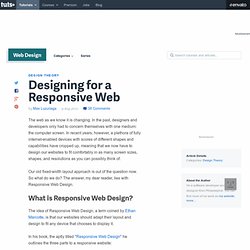

350 Photoshop Tutorials. Zombies! RUN! (Managing Page Transitions In Backbone Apps) One of the common issues or questions I see for Backbone.js goes something like this: “Whenever I hit the same route more than once, I end up getting seeing this call being made multiple times.

It seems to accumulate another call every time I hit the route. What’s going on?” Or “I’ve noticed that my views are still handling events after I remove them from the screen. “How do I make sure I clean things up when moving to a new page in my app?” At the heart of all of these questions is a problem that most backbone developers will run into at some point: zombies. The Plague: Event Binding The majority of the problems that people are referring to in these questions and issues are caused by the events that we bind to in our apps. We bind events to our DOM elements using the declarative `events` configuration in our views: We bind events from our models and collections so that our views can respond to changes and re-render themselves: Events are everywhere, and with good reason. Rule #2: Double Tap. Responsive Web Design Resources. Responsive Web Design. The English architect Christopher Wren once quipped that his chosen field “aims for Eternity,” and there’s something appealing about that formula: Unlike the web, which often feels like aiming for next week, architecture is a discipline very much defined by its permanence.

Article Continues Below A building’s foundation defines its footprint, which defines its frame, which shapes the facade. Each phase of the architectural process is more immutable, more unchanging than the last. Creative decisions quite literally shape a physical space, defining the way in which people move through its confines for decades or even centuries. Working on the web, however, is a wholly different matter. But the landscape is shifting, perhaps more quickly than we might like. In recent years, I’ve been meeting with more companies that request “an iPhone website” as part of their project. A flexible foundation#section1 Let’s consider an example design. Becoming responsive#section2 responsive architecture . Designing for a Responsive Web.
The web as we know it is changing.

In the past, designers and developers only had to concern themselves with one medium: the computer screen. In recent years, however, a plethora of fully internet-enabled devices with scores of different shapes and capabilities have cropped up, meaning that we now have to design our websites to fit comfortably in as many screen sizes, shapes, and resolutions as you can possibly think of. Our old fixed-width layout approach is out of the question now. So what do we do? The answer, my dear reader, lies with Responsive Web Design. What is Responsive Web Design? The idea of Responsive Web Design, a term coined by Ethan Marcotte, is that our websites should adapt their layout and design to fit any device that chooses to display it.
In his book, the aptly titled "Responsive Web Design" he outlines the three parts to a responsive website: A fluid gridFluid imagesMedia queries If you only read one of those, make it the last one, written in May of last year. I cannot design or code a responsive website. 45 top examples of JavaScript. JavaScript creates platforms that can engage a user and ensure that they remember your site and continue to revisit.

It can be used to create games, APIs, scrolling abilities and much more. The internet is full of web design inspiration, including great examples of JavaScript being used to bring a website to life and provide great user experiences. Here we pick some of our favourite examples of JavaScript in action for your inspiration. 01. Histography If you've ever watched Cosmos, you may remember Carl Sagan talking about the Cosmic Calendar. 14 billion years of events is a huge dataset, and displaying it in a browser is no easy task. The son of a historian, Stauber created Histography as a student at Bezalel Academy of Arts and Design, under the guidance of Ronel Mor.